Ancient Nuclear Warfare
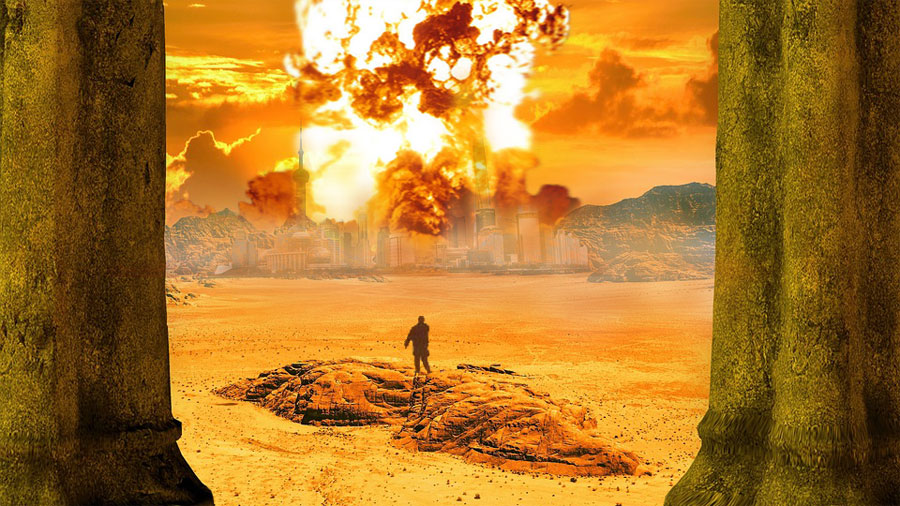 by Philip Coppens
by Philip Coppens
Vimanas Used In Atomic Warfare
Ancient India has made one of the greatest contributions to the concept of ancient flight: the vimana. At the World Space Conference on October 11, 1988, in Bangalore, India, Dr. Roberto Pinotti addressed the delegates and spoke on ancient Indian vimanas, telling them what the vimanas were and that they should take the subject seriously: that the vimanas should be studied as real flying machines. He was largely addressing the foreign delegates, for many Indian traditions hold the belief that their ancestors possessed technology that gave them the ability to fly.
References to vimanas can be found in the Yuktikalpataru of Bhoja (12th century AD), the Mayamatam, in 150 verses of the Rig Veda, the Yajurveda, and the Atharvaveda, as well as literary passages belonging to the Ramayana (fifth century BC), the Mahabharata (sixth century BC), the Puranas, the Bhagavata (ninth century AD), the Rahuvamsam, and references in the drama Abhijanaakuntalam of Kalidasa (second century BC, the Jatakas (third century BC), and several more. Some of these documents even give details on the mechanism of the vehicles. Chapter XXXI of the Samarangana Sutradhara contains details of the construction of this machine, and it has been found that one manuscript of this treatise is as old as AD 1610. There are 230 stanzas dealing with not only their construction, but also with take-off, their ability to cruise for distances of thousands of miles, and the danger of bird strike!
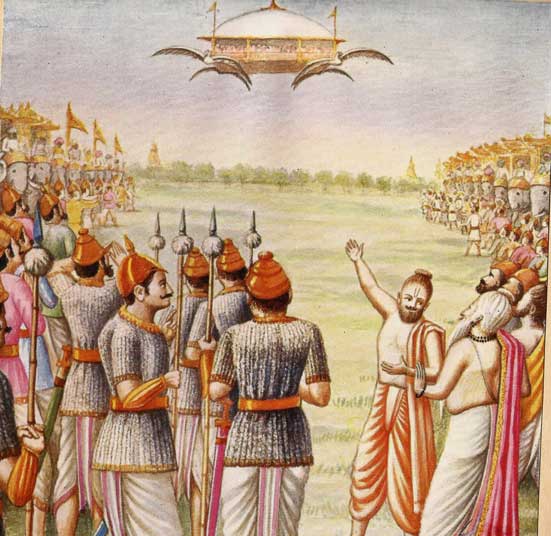 Since the 1960s, a number of organizations and experts have done complete books on the vimanas, including technical drawings, several of which are in English. In fact, B.G. Talpule wrote a book in Marathi entitled Vimana Kalecha Sodha in 1907, in which he described the vimana, which he said he had constructed a replica in 1895. It is the first printed text on flying machines in India, but Swami Dayananda Saraswati had previously argued that there were aerial flying machines in ancient Indian texts, and he interpreted verses of the Veda from that perspective.
Since the 1960s, a number of organizations and experts have done complete books on the vimanas, including technical drawings, several of which are in English. In fact, B.G. Talpule wrote a book in Marathi entitled Vimana Kalecha Sodha in 1907, in which he described the vimana, which he said he had constructed a replica in 1895. It is the first printed text on flying machines in India, but Swami Dayananda Saraswati had previously argued that there were aerial flying machines in ancient Indian texts, and he interpreted verses of the Veda from that perspective.
The Vedas say that the Rbhus built an aerial chariot for the use of the twin Asvinas, the physicians among the gods. The craft was comfortable and could move everywhere, including the heaven and sky. The vehicle could fly faster than the mind, was triangular, large, three-tiered, uneven, and piloted by at least three people. It had three wheels, and was made of gold, silver, or iron, though it was most often described as gold. It would come down with a great sound, and when it did, it was said that many people gathered to see its landing. It was said to also be able to land on the sea and then come to shore. When it moved on land, it left marks of its wheels. Apart from the three pilots, it could accommodate seven or eight people. It had scheduled flights: three at night and three during the day. Its departure was accompanied by loud sounds, which were said to make buildings tremble as well as uproot trees and small plants. The parallels between this story and the “vision” of Ezekiel are quite clear; maybe, indeed, Ezekiel was visited by a vimana?
Apart from vimanas, the Mahabharata also contains references to missiles, armaments, war machines, and the like. These weapons were said to have caused colossal destruction, comparable only to modern nuclear warfare.
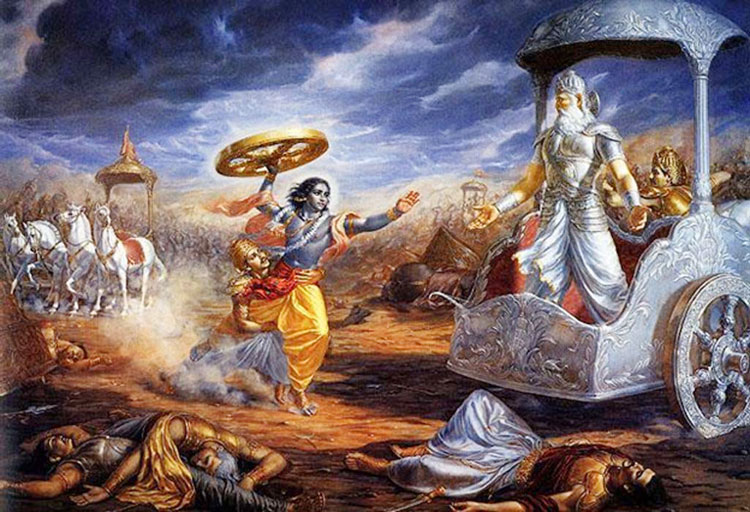 Passages of the Mahabharata read:
Passages of the Mahabharata read:
…[It was] a single projectile
Charged with all the power of the Universe.
An incandescent column of smoke and flame
As bright as the thousand suns
Rose in all its splendor…
… It was an unknown weapon,
An iron thunderbolt,
A gigantic messenger of death,
Which reduced to ashes
The entire race of the Vrishnis and the Andhakas.
… The corpses were so burned
As to be unrecognizable.
The hair and nails fell out;
Pottery broke without apparent cause,
And the birds turned white.
After a few hours
All foodstuffs were infected…
….to escape from this fire
The soldiers threw themselves in streams
To wash themselves and their equipment.
A detailed study into the question of whether vimanas and the related passages from the ancient Indian accounts are evidence of crafts with flight (if not spaceflight) capability was done by Richard L. Thompson, a scientist with a PhD in mathematics from Cornell University. He found that the numerous Indian texts gave accurate dimensions for the diameter of the Earth and even the plane of the ecliptic. The Puranas spoke of 400,000 human-like races living on various planets and of eight million other life-forms. Many of these races were said to possess siddhi, which humans could master, but were not born with. These siddhi were what in the West are labeled paranormal abilities, such as mental communication, but they also involved a number of techniques, such as changing the size or weight of objects, levitation, or moving objects through the ether without being impeded by physical obstacles, as well as entering another human being’s body and taking control of it.
On the subject of vimanas, Thompson found references to a vimana in the possession of the ancient Indian King Salva, which he had acquired from Maya Danava, an inhabitant of a planetary system called Talatala:
“Salva chose a vehicle that could…travel anywhere he wished to go, and that would terrify the Vrsnis. Lord Silva said, ‘So be it.’ On his order, Maya Danava, who conquers his enemies’ cities, constructed a flying iron city named Saubha and presented it to Salva. This unassailable vehicle was filled with darkness and could go anywhere. Upon obtaining it, Salva went to Dvarakak, remembering the Vrsnis’ enmity towards him. Salva besieged the city with a large army…. From his excellent airship he threw down a torrent of weapons, including stones, tree trunks, thunderbolts, snakes and hailstones. A fierce whirlwind arose and blanketed all directions with dust.”
 Dr. Dileep Kumar Kanjilal finds that if you delve into the literature of India, you come away with descriptions of modern tanks, armored cars, places for missiles on multi-wheeled carriers, sound interceptor missiles, ground-to-air and air-to-ground missiles, laser beams, and mass-destruction weapons similar to nuclear bombs. The Vanaparvan speaks of Arjuna’s weapon, the Pasupata, which had the potential to destroy the entire world. Arjuna was strictly forbidden to use this weapon against human beings. He also possessed the Narayana weapon, mentioned in the Dronaparvan. This, too, could create total destruction, and it killed instantly all life at the epicenter. The heat generated was equivalent to 100 times the power of the sun; the sky became filled with dust and strong winds, while trees were incinerated and the sound caused people far away to tremble with fear. In fact, there is a tradition that the war mentioned in the Mahabharata occurred in either 3127 BC (according to the Aihole inscription from the seventh century AD) or circa 1500 BC (according to modern scholars). Indeed, from around 1500 BC to 500 BC (the birth of Lord Buddha), no literary or historical records are found, and it is clear that a real dark age reigned over India.
Dr. Dileep Kumar Kanjilal finds that if you delve into the literature of India, you come away with descriptions of modern tanks, armored cars, places for missiles on multi-wheeled carriers, sound interceptor missiles, ground-to-air and air-to-ground missiles, laser beams, and mass-destruction weapons similar to nuclear bombs. The Vanaparvan speaks of Arjuna’s weapon, the Pasupata, which had the potential to destroy the entire world. Arjuna was strictly forbidden to use this weapon against human beings. He also possessed the Narayana weapon, mentioned in the Dronaparvan. This, too, could create total destruction, and it killed instantly all life at the epicenter. The heat generated was equivalent to 100 times the power of the sun; the sky became filled with dust and strong winds, while trees were incinerated and the sound caused people far away to tremble with fear. In fact, there is a tradition that the war mentioned in the Mahabharata occurred in either 3127 BC (according to the Aihole inscription from the seventh century AD) or circa 1500 BC (according to modern scholars). Indeed, from around 1500 BC to 500 BC (the birth of Lord Buddha), no literary or historical records are found, and it is clear that a real dark age reigned over India.
Mohenjo Daro literally means “Mound of the Dead.” Sometimes referred to as a metropolis of the ancient Indus Valley Civilization, it was built around 2600 BC and was one of the early urban settlements in the world. Whereas most ancient alien questions focus on the origin of civilization, at Mohenjo Daro, the question has to do with how and why the city was abandoned around 1500 BC.
The site was rediscovered in 1922 when an officer of the Archaeological Survey of India, Rakhaldas Bandyopadhyay, was led to the site by a Buddhist monk. A decade later, excavations began. And as the excavations progressed, they found hundreds of scattered bodies—in the middle of the street, some still holding hands. People were just lying, unburied, in the streets of the city; there seemed no one available to bury them.
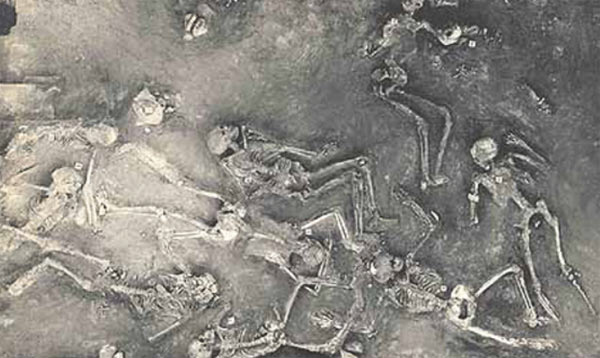 What could cause such devastation? Why did the bodies not decay or get eaten by wild animals? Furthermore, Alexander Gorbovsky, in Riddles of Ancient History (1966), reported on the discovery of at least one human skeleton in this area with a level of radioactivity approximately 50 times greater than it should have been due to natural radiation. Also, thousands of fused lumps, christened “black stones,” have been found at Mohenjo Daro. These appear to be fragments of clay vessels that melted together in extreme heat, around 2,550–2,910 degrees F. The centers of both cities bear the traces of an explosion or something resembling it. The buildings are literally leveled. Whatever ended Mohenjo Daro, it was sudden, and extreme.
What could cause such devastation? Why did the bodies not decay or get eaten by wild animals? Furthermore, Alexander Gorbovsky, in Riddles of Ancient History (1966), reported on the discovery of at least one human skeleton in this area with a level of radioactivity approximately 50 times greater than it should have been due to natural radiation. Also, thousands of fused lumps, christened “black stones,” have been found at Mohenjo Daro. These appear to be fragments of clay vessels that melted together in extreme heat, around 2,550–2,910 degrees F. The centers of both cities bear the traces of an explosion or something resembling it. The buildings are literally leveled. Whatever ended Mohenjo Daro, it was sudden, and extreme.
Albion W. Hart was one of the first engineers to graduate from the Massachusetts Institute of Technology (MIT). During an engineering project in Africa, he and his colleagues were traveling through the desert. Margarethe Casson, in an article on Hart’s life in the magazine Rocks and Minerals (no. 396, 1972), writes, “At the time he was puzzled and quite unable to explain a large expanse of greenish glass which covered the sands as far as he could see. Later on, during his life, he passed by the White Sands area after the first atomic explosion there, and he recognized the same type of silica fusion which he had seen 50 years earlier in the African desert.”
Robert Oppenheimer was an American theoretical physicist and is often called the “father of the atomic bomb” for his role in the Manhattan Project, the World War II project that developed the first nuclear weapons. Oppenheimer had studied Sanskrit. He obviously witnessed the first atomic bomb detonation on July 16, 1945, in the Trinity test site in New Mexico. Afterward, he quoted from the Bhagavad Gita: “I have unleashed the power of the Universe, now, I am become Death, the destroyer of worlds.” In 1952, at a press conference at the University of Rochester, he was asked whether the Trinity test was the first ever nuclear detonation carried out. He replied, “Yes…in our times.”
It is clear that Oppenheimer was convinced of the reality of the ancient Indian accounts and felt that what he had accomplished at the Manhattan Project was merely the rediscovery of a science. And so, whereas our ancestors were clearly capable of building the most beautiful and largest of structures, they clearly were also able to wipe them out.
According to Zecharia Sitchin, atomic nuclear warfare is precisely what occurred in the Middle East in the third millennium BC. In support of this conclusion, Sitchin consistently pointed to photographs of the Sinai Peninsula, taken from space. They purportedly showed an immense cavity and crack in the peninsula’s surface, revealing where a nuclear explosion had taken place. He explained that the area was strewn with crushed, burnt, and blackened rocks, which contained a highly unusual ratio of the isotope uranium 235, “indicating in expert opinions exposure to sudden immense heat of nuclear origin,” to quote Sitchin.
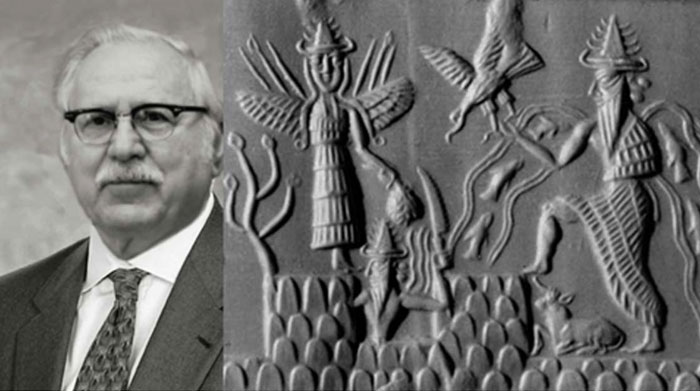 In recent publications, Sitchin has also argued that the article “Climate Change and the Collapse of the Akkadian Empire: Evidence from the Deep Sea,” which was published in the April 2000 issue of Geology, is confirmation of his claim. The essay argues that an unusual climate change occurred in the areas adjoining the Dead Sea, which gave rise to dust storms, and that the dust—an unusual “atmospheric mineral dust”—was carried by the prevailing winds over the Persian Gulf. According to Sitchin, this was due to an “uncommon dramatic event that occurred near 4,025 years before the present,” or about 2025 BC. He added that the water level of the Dead Sea fell abruptly by 100 meters at the time, further indicating that something truly catastrophic did happen. Most agree that there is a likelihood that these ancient cities may were irradiated by an atomic blast. If true, it would be impossible to ignore the conclusion that these ancient civilizations possessed forms of very high technology.
In recent publications, Sitchin has also argued that the article “Climate Change and the Collapse of the Akkadian Empire: Evidence from the Deep Sea,” which was published in the April 2000 issue of Geology, is confirmation of his claim. The essay argues that an unusual climate change occurred in the areas adjoining the Dead Sea, which gave rise to dust storms, and that the dust—an unusual “atmospheric mineral dust”—was carried by the prevailing winds over the Persian Gulf. According to Sitchin, this was due to an “uncommon dramatic event that occurred near 4,025 years before the present,” or about 2025 BC. He added that the water level of the Dead Sea fell abruptly by 100 meters at the time, further indicating that something truly catastrophic did happen. Most agree that there is a likelihood that these ancient cities may were irradiated by an atomic blast. If true, it would be impossible to ignore the conclusion that these ancient civilizations possessed forms of very high technology.
A layer of radioactive ash was also found in Rajasthan, India, after a very high rate of birth defects and cancer was discovered in that area. It covered a 3-square-mile area, ten miles west of Jodhpur. The levels of radiation registered so high on investigators’ gauges that the Indian government cordoned off the region. Scientists then apparently unearthed an ancient city where they found evidence of an atomic blast dating back thousands of years: from 8,000 to 12,000 years ago. The blast is said to have destroyed most of the buildings and probably a half-million people.
Archaeologist Francis Taylor stated that etchings he translated in some nearby temples suggested that the local population prayed to be spared from the great light that was coming to lay ruin to the city. “It’s so mind-boggling to imagine that some civilization had nuclear technology before we did. The radioactive ash adds credibility to the ancient Indian records that describe atomic warfare.”
Whereas the story of the Mahabharata is indirect evidence, the archaeological and geological discoveries in India pose serious problems for those trying to deny the possibility of ancient atomic warfare. What makes it all the more remarkable is that these indications were found in a corner of the earth where accounts say that just such horrible warfare had occurred! Indeed, when confronted with these findings, one skeptic stated, “I am sick and tired of hearing this [the possibility of an atomic explosion in India], and I cannot find any debunks of this either. [Is there] anyone who can debunk this, or is this really true?” That is indeed the question—and it is an important one. The stakes are high, as one would expect when facing the best evidence for ancient advanced technological civilizations.
Until the subject is seriously tackled, the bodies of Harappa and Mohenjo Daro remain a mystery. The anomalous crater adds power to the ancient nuclear-warfare possibility, as does other circumstantial evidence, such as the Mahabharata. Finally, the fact that all these enigmas are within the same general region (as opposed to scattered across the world) adds even further weight to the case.
Excerpt from The Ancient Alien Question
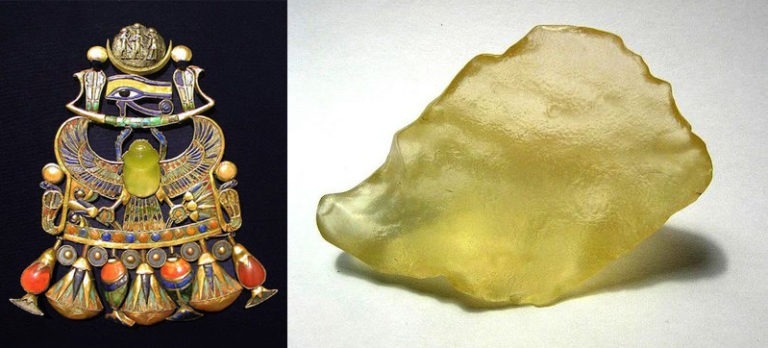 Fused Glass Everywhere
Fused Glass Everywhere
In 1952 archaeologists conducting excavations in Israel discovered a layer of fused green glass. The layer was a quarter of an inch thick and covered an area of several hundred square feet. It was made of fused quartz sand with green discoloration, similar in appearance to the layers of vitrified sand left after atomic tests in Nevada in the 1950s.
Five years earlier a thin layer of the same glass was dug up below the Neolithic, Sumerian and Babylonian strata in southern Iraq.
To the south, the western Arabian desert is covered with black rocks that show evidence of having been subjected to intense radiation. These broken and burned stones are called “harras” that are strewn over an area of 7,000 square miles.
“Some single fields are one hundred miles in diameter and occupy an area of six or seven thousand square miles, stone lying next to stone so densely packed that passage through the field is almost impossible. The stones are sharp-edged and scorched black. No volcanic eruption would have cast scorched stones over fields as large as the harras. Neither would the stones from volcanoes have been so evenly spread. The absence in most cases of lava ( the stones lie free) also speaks against a volcanic origin for the stones…” ~ Immanuel Velikovsky, author of Earth in Upheaval
A small piece of unusual yellow-green glass carved into the shape of a beautiful scarab beetle is a part of the famous pectoral of Tutankhamun and can be seen in Cairo Museum, Egypt. The jewel was tested and found to be glass, but surprisingly it is older than the earliest Egyptian civilization.
An extended area of strange, glassy stretches of fused silica have also been found in the most desolate areas of the Gobi Desert in Mongolia. Especially interesting are the layers discovered at Lop Nor in Sinkiang, in the vicinity of a present Chinese atomic site. The results obtained from examined radioactive surface in the area indicate that layers of fused silica does not originate from the modern nuclear detonations but had been there long before China became a nuclear power. This would mean that Gobi’s fused silica comes from the very distant past.
In 1908-09, ancient ruins of the city of Khara Khoto were unearthed, in the Tangut province, located about 300 kilometers from the famous Silk Highway. Working in one of the excavation sites, Piotr K. Kozlov, the Russian archaeologist dug up a sarcophagus with two well-preserved bodies of an unknown king and queen. According to his estimations, the sarcophagus was buried about 12000 BC. In another excavation of the same ruins, Professor Kozlov unearthed a large bottomless pit at the depth of 1800 meters. Its vitrified melted walls looked like glittering blue glass.
“Some phenomenon unknown to us must have melted the very stone and left the shiny glazed walls. Local tradition speaks of lightning bolts crashing down from the heavens and hollowing out this excavation. But what kind of lightning can carve out an excavation almost a mile-and-a-quarter deep and leave it with glittering blue walls?” ~ Hartwig Hausdorf, author of The Chinese Roswell
The fused glass that can be found in many places around the world has a long history and provides physical evidence that atomic explosions were a part of Earth’s history in the ancient past.
by A. Sutherland (ancientpages.com)
Posted in Other Topics, True History of Manwith comments disabled.


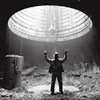
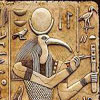

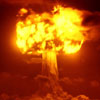
[…] damit sie für die Nachwelt späterer Zeit erhalten blieben. Damals herrschten laut antiken Texten reale menschenähnliche Götter über die Menschen der Erde und führten gewaltige Kriege – […]